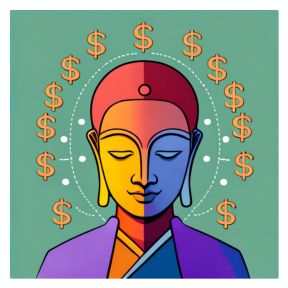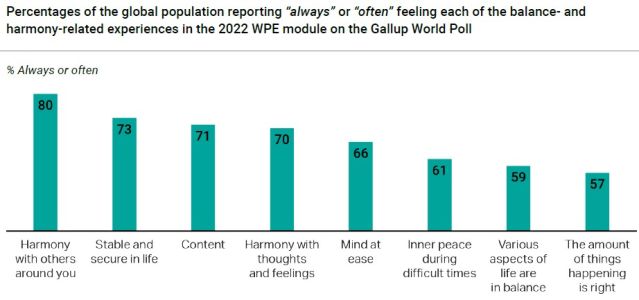HAPPINESS- Global Happiness: 4 Out of 5 People Feel Harmony With Others. People trend toward happiness but find life balance and right outcomes harder. Reviewed by Ray Parker

KEY POINTS-
- Psychological states common to all demographics include balance, harmony, inner peace, and contentment.
- Inner harmony is the most frequent theme in people’s definitions of happiness.
- People with high levels of education report being happy more often than those with low education levels.
A recent global study sheds new light on how individuals around the world experience relationships with themselves and others and the interplay of these characteristics with earlier happiness studies.
For many years, gross domestic product (GDP) was considered the primary factor in living the good life. Then millions of people responded to the United Nations and Gallup's World Happiness Study, relating that other factors such as social cohesiveness, government reliability, absence of corruption, and gender equity affect their happiness; increased GDP doesn’t always correlate with greater happiness.

The World Happiness Study ranks nations based on respondents’ answers about how often they feel the peak emotions of joy, anger, laughter, and sadness and the factors that affect those feelings. However, these Western measures of happiness do not explore the calm and contemplative ways that people define happiness for themselves, such as a sense of purpose or social status.

The Harmonic Principles
On Sept. 20, 2023, Gallup and the Japan-based Wellbeing for Planet Earth Foundation (WPE) further advanced the study of global happiness with their report, Wellbeing for All: Incorporating Harmonic Principles of Wellbeing in Subjective Wellbeing Research and Policymaking. The report considers a globally nuanced take on happiness, supplying the responses of people who report how often they feel contented, harmonious, and balanced, expressed as regional, national, and world percentages.
The researchers call these the harmonic principles of well-being and identify four psychological states that are common across all areas and socioeconomic demographics: balance, harmony, inner peace, and contentment in life. They say these principles complement traditional happiness models and depict them as dynamics of balance and harmony that include work-life balance and the closely associated positive states like peace and calmness.
Inner Harmony
The study was conducted through the 2022 Gallup World Poll with respondents 15 years or older from 142 countries. Respondents rated the frequency of these experiences on a four-point scale (“always,” “often,” “rarely,” “never”). The questions were crafted based on the results from a global survey asking people in 130 nations what psychological states characterize happiness.
Inner harmony is identified as the most frequent theme in people’s definitions of happiness. The authors note that the global percentages are heavily influenced by India and do not include China because no data were collected from China in 2022.
The finding that people in high-income regions of the world, including Northern America, East Asia, Europe, Australia, and New Zealand, experience both balance and harmony more often than those in low-income regions is consistent with earlier findings. Less than half (48 percent) of the global population who struggle financially feel that their mind is at ease.
Even fewer of those who struggle financially feel balance and peace. Only 44 percent of those struggling financially report frequent feelings of inner peace, only 41 percent report experiencing balance in life and only 45 percent report that the number of things happening in their lives is the “right” amount. This is in stark contrast to the financially well-off who report frequently experiencing feelings related to harmony, balance, peace, contentment, stability, security, and ease of mind.
Higher Education
The report finds a marked difference between the happiness levels of people with higher education compared to those who are less educated. This correlates with the less-publicized historical finding of other happiness studies that easy access to higher education supports well-being.
Inner vs. Outer Harmony
What emerges from the report’s findings shown as percentages is how often various groups of people identify with emotions related to balance and harmony. This new approach to scoring happiness provides some startling observations on the human condition.
One of the remarkable findings is that the global population experiences harmony with those around them whether rich or poor, educated or not, male or female, even if often feeling like life is out of balance or experiencing financial insecurity.
In every demographic, feelings of harmony are reported more frequently than feelings of balance. Eighty percent of the people in the world feel harmonious with people around them, irrespective of their financial or social status. Even in the lowest psychological states, 70 percent of people globally report feeling harmonious with others more often than not.
The other finding of note is that most people find external harmony more easily than internal harmony and that life balance is a universal challenge regardless of educational or socio-economic status. A large majority of the global population (80 percent) reports “always” or “often” experiencing harmony with others, while 70 percent also experiences feelings of stability and security, contentment, and harmony with their thoughts and feelings.
Life Balance and Things Happening Right
It seems to be part of the human experience to struggle to find internal balance. Only a slight majority of the global population report feeling that the various aspects of their lives are in balance (59 percent) and that the amount of things happening in their lives is just right (57 percent).
Even those with high education levels and financial security report that 80 percent of the time, they feel stable and secure, in harmony with themselves, and content with life and have a more tenuous grasp of balance and a sense of things happening just right. Only 68 percent feel the amount of things happening is just right, and only 73 percent feel the various aspects of their lives are in balance.
As a side note, the report finds that around the world, the majority of people prefer a calm life, with particularly higher preferences for a calm life in poorer countries. According to this widespread study, the natural condition of humankind trends toward harmonious relationships with others, despite apparent internal conflict about things happening just right and balancing the various aspects of life.
- Questions and Answers
- Opinion
- Motivational and Inspiring Story
- Technology
- Live and Let live
- Focus
- Geopolitics
- Military-Arms/Equipment
- Sicherheit
- Economy
- Beasts of Nations
- Machine Tools-The “Mother Industry”
- Art
- Causes
- Crafts
- Dance
- Drinks
- Film/Movie
- Fitness
- Food
- Spiele
- Gardening
- Health
- Startseite
- Literature
- Music
- Networking
- Andere
- Party
- Religion
- Shopping
- Sports
- Theater
- Health and Wellness
- News
- Culture

